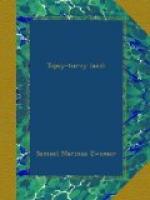You think I am making fun but it is really true that in western Arabia there is a house that always wears an overcoat. This is a large, square stone house without windows and with only one door to let in the light and the air; it is empty inside, although crowds gather around it as you see in the picture. Yet this house always has on an overcoat of black silk, very heavy and richly embroidered. Every year the old coat is taken off and a new one put on. A few days ago a Moslem pilgrim showed me a piece of the cloth of last year’s overcoat and he was very proud of it. It was indeed a fine piece of heavy silk and the names of God and Mohammed were prettily woven into the cloth. This man had just come from visiting the square-house and I will tell you what he saw.
The place he visited with hundreds and thousands of other pilgrims is called Mecca and the square-house is the Beit Allah or house of God to all Mohammedans. It is also called the Kaaba, which is the Arabic word for a cube.
The Moslems believe all sorts of foolish things about the Kaaba. They say Adam built it as soon as he fell down on the earth out of Paradise, and that Abraham repaired it after it had been ruined by the flood in the days of Noah. They even show a large white stone on which Abraham and Ishmael stood when they plastered the walls; the stone still bears the impress of Abraham’s feet, they say. Did you ever hear such a topsy-turvy story?
The building is about twenty-four cubits long and wide and nearly twenty cubits high. It has no ornaments or beauty except one rain-spout to carry the water off the flat roof; you can see it on the right side of the Kaaba on the picture. This spout is said to be of pure gold. In one corner of the building is a large black stone which is also an object of worship. The Mohammedans say it came down from heaven with Adam and was once pure white. By the many kisses of sinful worshippers it has turned black. Not only is it black but broken. For about three hundred years after Mohammed’s death the stone remained imbedded in the walls of the Kaaba, but then some wild Arabs from the Persian Gulf came, sacked Mecca and stole the black stone. It was carried to Katif, a place near Bahrein, right across Arabia, and they kept it a long time until the people of Mecca paid a large sum of money and carried it back. On the long journey it must have fallen from the camel because, at present, it is cracked and the broken pieces are held together by a silver band. There once were a great many of these stone idols in the Kaaba, but Mohammed destroyed them all except this one when he became master of Mecca.
[Illustration: THE SQUARE HOUSE WITH THE BLACK OVERCOAT.]
At present the stone house is empty of idols and yet all the Moslems turn in the direction of this old heathen temple to pray. The cloth that covers it comes every year as a present from the Khedive of Egypt, who is a Mohammedan. It is very costly and is sent on a special camel, beautifully decked with trappings of gilt, and a large throng of pilgrims go along to escort the overcoat.




